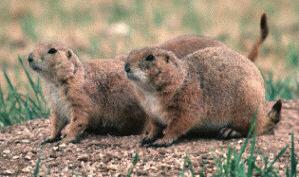Black-tailed Prairie Dog (Cynomys ludovicianus)

TPWD ©
- Description
- A close cousin of the ground squirrel, the Black-tailed Prairie Dog is a heavy-bodied rodent with a black-tipped tail. Prairie dogs have large eyes, short tails and a brownish-tan pelage.
- Life History
- Prairie dogs play an important role in the prairie ecosystem. They serve as a food source for many predators and leave vacant burrows for the burrowing owl, the Black-footed Ferret, the Texas horned lizard, rabbits, hares, and even rattlesnakes.
Prairie dogs are very social animals. They live as a group in prairie dog "towns" which range from one to over 1,000 acres. These towns are subdivided into wards that are arranged like counties within a state. Wards are further subdivided into distinct social units called coteries. A coterie usually consists of a single adult male, one to four adult females, and any offspring under two years of age. Movement between wards is uncommon; however, among family members, prairie dogs greet each other with bared teeth with which they "kiss" as a form of recognition.
Prairie dogs are strictly diurnal animals. They are most active during the cool hours of the day, when they engage in social activities such as visiting and grooming each other as well as feeding on grasses and herbs. When prairie dogs are out, a sentry perches on the volcano-like ring that surrounds the burrow. Should a predator or any other danger become evident, the sentry will bark out a warning, after which the community will dive into their burrows and wait for the "all clear" call before venturing out again.
Female prairie dogs produce only one litter of approximately four to five young per year in March or April. The pups are born blind and hairless after a gestation period of 34 to 35 days. They do not make an appearance outside the burrow until they are about six weeks of age. Not long after, the family gradually will disperse. The young males of the family usually move away before their first breeding season while the females may spend their entire lives in their original coterie. Female prairie dogs may live up to eight years of age while male prairie dogs usually live to be no more than five years of age. - Habitat
- Prairie dogs are native to short-grass prairie habitats of western North America. They avoid heavy brush and tall grass areas due to the reduced visibility these habitats impose.
- Distribution
- Prairie dogs are native to the western North American plains. In Texas, they may be found in western portions of the state and in the Panhandle. Huge prairie dog towns, such as one that covered 25,000 square miles and supported a population of approximately 400 million prairie dogs, once were reported from Texas. Although prairie dogs still locally are common, today less than one percent of the prairie dog population and habitat remain.
- Other
- Prairie dogs have been pushed out of their native habitat ranching and farming activities for the past 50 years or more. As a result, their former range and numbers have shrunk dramatically. Although it is true that large concentrations of prairie dogs can damage cultivated crops or compete seriously with livestock, the wisdom of eliminating them entirely from rangelands has not been proven. Ranchers in certain parts of Texas, for example, claim that removal of prairie dogs is related to the undesirable spread of brush. This has had detrimental effects on the livestock industry which far outweighs the damage prairie dogs might do.